Photo Credit: Dallas Baptist University Baseball
This is the third in a series of posts rolling out There R Giants Top 50 prospects for 2021. To read the previous installments:
For awhile, this 31-40 group was actually my second favorite decade in the entire top 50. A last second switcheroo of a couple players turned the wattage of my delight down a notch, but this still a really strong segment of the list and includes more than one personal cheeseball of mine. We’ll talk more about discipline and swing decisions, meet some more arm-strength goofs, and come face to face with an honest-to-god 80 grade tool or two. It’ll be fun!
Just as a reminder, in this post I’ll be using the 20-80 scouting scale to refer to player’s Future Value (FV), utilizing the great work done by Kiley McDaniel and Eric Longenhagen at Fangraphs. I’ve also added risk factors and lowered FV expectations for players far away. Here’s a handy guide with familiar examples to keep a picture in your mind on what the FV grades mean:
80: Franchise Player, #1 starter (Mike Trout, Clayton Kershaw)
70: Perennial All Star, #2 starter (Nolan Arenado, Stephen Strasburg)
60: Occasional All-Star, #3 starter, Elite Reliever (Jose Abreu, Mariano Rivera)
55: First Div. Regular, #3/4 starter, Closer (Brandon Crawford, J. Samardzija, Z. Britton)
50: Average Regular, #4 Starter, Set Up RP (Cesar Hernandez, Tanner Roark, A. Ottovino)
45: 2nd Division Reg or Platoon player, #5 starter, low leverage reliever
40: MLB Bench Player/Reserve
35: Up and Down/Depth Player
30: Triple-A Player
20: Organizational player
#40. Prelander Berroa, RHP
DOB: 4/18/00
2019 Highest Level: A-
Potential 2021 Level: Low A
Acquired: Trade, Sam Dyson to Minnesota Twins
Future-Value Grade: 40 (Risk: Extreme)
To pull back the curtain to the sausage factory for a moment, there’s an excellent “Player A or Player B” argument to be had here. The Giants have in their organization a soon-to-be-25-year-old right-hand reliever (Player A) who has reached the upper minors. Player A throws a fastball that hits 98-99, a hard snapping breaking ball, and change that is at least average and sometimes better than that. He’s had great success in A ball; less so in AA. They have another right-handed pitcher who will be 21 next year, likely a reliever long-term though with hopes for more. Player B can throw an upper 90s fastball and also shows inconsistent slider and change that sometimes look to have potential but sometimes don’t look like much at all. Player B has spent nearly his entire three year career in rookie ball and most recently looked somewhat overmatched in a short stint in short-season ball where he showed no basic strike-throwing ability at all.
Which of the two would you prefer? And if Player A was your preference, why did I leave him off the Top 50 entirely while sneaking Player B in at the 40 spot? These are all excellent questions — and I’ve been asking them of myself for a couple weeks now. For a brief moment I thought I was spared the problem of ranking Raffi Vizcaino (Player A) when he became a minor league free agent after the World Series….but alas, the Giants immediately re-signed him and dumped him back in my lap.
Vizcaino is, by my definitions above, at least a 30 role player and quite possibly a 35 — I wouldn’t at all be shocked to see him called up for a day or two at some point in 2021. But as I said in my opening installment of this series, those grades are a pencil sketch that gets filled in with ink the older a player gets and the higher up the ladder they climb. And at this point, Raffi Vizcaino is getting pretty close to oil painted in my head as guy with tremendous stuff whose well below average command cause the whole package to play down. He also doesn’t appear to have a lot of athleticism about his body, which may be part of the reason he’s missed so much time on the IL in his career.
Now an uncharitable view of Berroa might be that maybe someday (with good fortune) he develops into the pitcher that Vizcaino is today. Vizcaino’s below average command causes his stuff to play down, but it doesn’t cause it to disappear altogether. Northwest League hitters yawned their way through free passes with dispiriting frequency during Berroa’s stint in Salem-Keizer. But a more positive point of view on Berroa would suggest the makings of a power arsenal that he can learn to control a little better as he matures. If the command tightens up and both his secondaries come along there’s the outlier chance of a power starter; if just one of them comes forward you have the fallback of power reliever.
So, in other words, I’m falling back on the great Logical Fallacy of Prospecting — pick the guy you haven’t seen fail yet? That’s a TERRIBLE way to rank! And yes, I may be, and Yes, it is. But there’s still the issue of Asset Valuation here to consider. Vizcaino has now reached his minor league free agent period of his career and will be free at the end of every year from here on out (until and unless someone adds him to a 40-man). There are literally dozens of other pitchers much like him freely available on the minor league market every winter. Berroa is still a young arm with promise who can be controlled and developed over time and makes an interesting throw-in to help finalize trade talks — as indeed he was in the Giants’ Sam Dyson trade, where he was the final piece along with Jaylin Davis and Kai-Wei Teng. There’s legitimate value in that kind of promise.
If I was forced to wager on one of these two guys spending a single day in a major league dugout at some point in time, I’d put it on Vizcaino. But Berroa gets the boost on long term value. Now develop a little control, please Prelander!

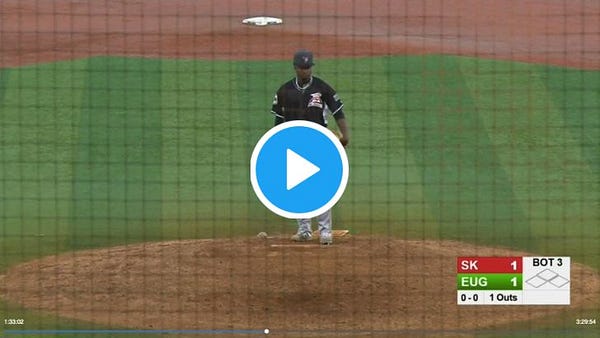
#39. Rayner Santana, C
DOB: 8/15/02
2019 Highest Level: Rookie (Foreign)
Potential 2021 Level: Rookie (Domestic)
Acquired: International Free Agent (2018)
Future-Value Grade: 40 (Risk: Extreme)
There seemed to be so much good news happening all at once in the Giants’ system in 2019 that it was a little hard to keep it all together in your head. But there was probably no one player whose success was as big of a surprise as Rayner Santana’s. The young Venezuelan catcher would have classified in the 2019 international class had he been born just a couple of weeks later and consequently was one of the youngest players in all professional baseball in 2019, playing nearly the entire season at 16.
And boy howdy did he play! Santana came very close to setting a known team record for HRs (DSL statistics only go back to 2005 on Baseball-Reference), becoming the first teenager to pound double-digit HRs for the DSL Giants. I talked with Ben Badler about Santana’s debut earlier in the summer and here’s what Ben had to say:
Really, really young for his class…He went out and demolished that league. He hit, he hit for power, his strikeouts were a little high….I remember seeing him as an amateur. He came over to the Dominican Republic and played in an International Prospect League and he didn’t really stand out to me. There’s always a big glob of Catchers from Venezuela who sign in that 100-500k range and it’s, like, “pick your flavor” of guy. So he wasn’t a guy that jumped out when I saw him. But obviously the debut he had — to hit for that kind of power! He certainly looks like a guy who could be a Catcher who could hit 25 HRs. There’s still some holes in the swing but it almost sounds a little nit-picky because he was 16 pretty much all of last year….He does have a strong arm, in terms of blocking and receiving he has to clean some things up there. But to get that kind of guy in your class — you’d be excited about it anyway but the fact that he’s probably the fourth best guy in that signing class….that’s a pretty good sign that you’ve got a pretty outstanding signing class.
What prevents me from boosting Santana higher up this list is a fear of relying too much on statistics from the DSL — a level of notoriously low competition where statistics have long proven to have unreliable predictability. If he had just a little more scouting pedigree you wouldn’t be reading about him until next week. That said, a lot can happen to a teenager’s body between 14-16 and between 16-18 and something certainly happened to Santana’s because he did things with the bat in 2019 that 16 year olds just don’t do in the DSL. Another campaign like this and he’ll turbo-charge up the rankings whether he looks like a big league catcher or not (and as noted in Adrian Sugastey’s writeup, catcher is a position where external factors could really be changing the traditional profile over the next few years).
If he did nothing else, ten homer power out of a 16 year old body is noteworthy. But he also hit near .300 and posed an OBP well over .400. That was enough to get Santana an invite to Arizona for spring training, where he’s spent his entire COVID year. Along with Sugastey (who’s just two months younger than Santana) he was the youngest position player invited to the Giants Instructional League camp.
#38. Jimmy Glowenke, INF
DOB: 6/05/99
2019 Highest Level: N/A
Potential 2021 Level: Low A
Acquired: Drafted, 2nd Rd (2020)
Future-Value Grade: 40 (Risk: Extreme)
I feel like I like Jimmy Glowenke more than anybody else does. Maybe not his mother. Hopefully not more than the Giants! But more than most.
Glowenke belongs to a specific sub-phylum of Zaidi acquisitions who I’m fascinated with — not because they’re the type of prospects I typically incline to, but rather because they’re so obviously the type of prospects that the Giants’ new modeling analytics incline to. This is the type of guy who just feels like someone the Giants should be successful in developing if they’re going to realize their vision for the future. Jimmy Glowenke possesses virtually every trait that Zaidi, Scott Harris, and Gabe Kapler constantly talk about valuing.
First and foremost, the dude hits. Though playing at Dallas Baptist University doesn’t expose him to the highest level of D1 competition, he still posted an excellent .340/.433/.506 career line there (and actually, as DBU has been a high-velocity pitching factory the last several years, live BP and intrasquads are actually pretty good tests at that school). His Junior year was starting out to be a quantum leap, as he hit .415 with a .957 OPS in the shortened spring. His work with wood bats was also strong as he hit .296 in the Cape Cod League as a rising Sophomore and .283 in the Great Woods League following his Freshman year.
That’s all burying the lede though, because it’s his plate discipline numbers that grab the most attention. Over 3 (well, 2.5) years at Dallas Baptist Glowenke walked almost as much as he struck out, 67:76. That’s a tiny 11.5% K rate and a very healthy 10.5% BB rate. Not quite Joe Panik level but close! Again, that didn’t come against elite D1 pitching but Dallas Baptist did play frequent non-conference series against ACC and SEC opponents. He showed the same control of the strike zone in the Cape Cod League (12:14). He makes, in other words, good swing decisions — which at this point should be a There R Giants’ drinking game.
He also hit the ball hard and showed solid slugging everywhere he played, with a career high 10 HRs in his Freshman year at DBU. Glowenke’s defense is more of a mixed bag — though he was the MVC Defensive Player of the Year his Freshman Year. On the whole, Glowenke shows excellent instincts and hands, though his arm may be too short for the left-side of the infield. He was forced to DH last spring while recovering from a non-TJ arm surgery. Back when I reviewed the Instructional League roster I dropped a little Wilmer Flores comp on Glowenke if you want to dream big. Tons of contact, some pop, the ability to move around the infield if not necessarily to cover himself in glory at any position. There could be a Donnie Barrels sort of outcome here, there could be a contact-oriented utility player. But there should be something that the Giants can mold into productive clay.
We can’t lose sight of the fact that Glowenke was the only one of the Giants top five draft selections last year who signed for <$1 million (and far less, at $597k) and that certainly played a significant factor in his selection. But they weren’t just drafting a $$ figure — there are clear things about Glowenke’s game that appeal to this organization; and they no doubt believe they can get the best out of his skills in the years to come. As I talked about with Grant Brisbee, it’s the success of this type of player that will indicate the Giants are building a sustainable development model. Not the superstars, whose development is tied to their sui generis abilities. It’s the Glowenkes we need to be watching for.
#37. Ghordy Santos, SS
DOB: 9/02/99
2019 Highest Level: Rookie (Domestic)
Potential 2021 Level: Low A
Acquired: International Free Agent (2016)
Future-Value Grade: 40 (Risk: Extreme)
Now let’s balance up the scales a little bit and transition from a player I’m fascinated by because the Giants love him, to a player I’m fascinated by because I love him! In fact I probably should have saved my Jimmy Glowenke open for just one more spot, because I DEFINITELY love me some Ghordy Santos more than anyone else!
Way back in the fall of 2016 there were reports that the coaches at the Felipe Alou Academy were impressed by Santos’ play in his first Dominican Instructional Camp. He was twitchy and athletic, he showed outstanding actions and hands, a strong arm and excellent internal clock at the shortstop position. And he was mature and smart and dedicated. Of course, you heard reports that they were also smitten by Samuel Jorge and that story hasn’t progressed all that well. The promise of glory with teenagers often leads but to the waiver wire.
And Santos did little to prove his promise would actualize over two, difficult seasons in the DSL where he hit just .219 over 109 games. You could look for glimmers of positivity if you wanted. He walked more than he struck out, posting an incredible 20% BB rate — though I always maintain that not swinging the bat probably shouldn’t be the thing you do best at the plate. It’s a valuable skill to be sure, but mostly because it should contribute to you doing other, better things — like hitting the ball hard when you do swing it. Santos also did show some slight ability for hard contact as more than a third of his hits went for extra bases. Still, Dominican pitchers are the bottom of the competitive barrel and barely sneaking over the Mendoza Line against them is no cause for boasting.
But the Giants didn’t let the lack of on-field success dissuade them from their enthusiasm for Santos — which is what we really should pay attention to. They invited him stateside for Instrux in 2018 and again for spring training. And before the 2019 AZL season began they made sure to put Santos on the team that didn’t have Marco Luciano to make sure Santos got playing time at SS. These are the little, hidden things that speak volumes in player development. Santos rewarded the Giants faith with an excellent .314/.398/.430 AZL season and continued to catch the eyes of AZL scouts with his twitchy athleticism.
This fall The Athletic’s Melissa Lockard asked Kyle Haines whether players like Santos and Dilan Rosario were “following Marco [Luciano’s] lead” and Kyle gave a telling response: “Ghordy’s a leader in his own right.” It’s been a slow burn so far, but the Giants have never cooled in their appreciation for this talented 21 year old. Now at the age of a typical college junior, it could be time for Santos to blossom.
#36. Tyler Cyr, RHP
DOB: 5/5/93
2019 Highest Level: AAA
Potential 2021 Level: AAA
Acquired: Drafted, 10th Rd (2015)
Future-Value Grade: 35+ (Risk: Low)
No need to re-invent the wheel here, you probably remember my writing about Cyr when guessing who was in line for 40-man additions (which should happen in the next two weeks). Here’s what I said then:
Cyr probably doesn’t have the relief star ceiling of Doval, but he also was part of the Sacramento pool and, unlike Doval, he’s performed exceptionally well in AA — he came back from elbow-fracture surgery throwing much harder than he had in 2017, and he’d been a good reliever even then. While Cyr might be more enticing to other teams if he had a 2020 AAA line on his B-Ref page, the Giants were one of the teams sharing scouting data from Sacramento, so teams do have some insight into his performance. While I’m sure they might prefer to leave him off the 40 man for now and then promote him when the time comes in 2021, for a team that is short on right-handed relief there’s probably just a touch too much risk in that strategy. He has a real Rule 5 selection profile. That probably makes him risky enough to protect.
Cyr is very near the top of my “Who is going to make their MLB debut in 2021” list. He’s really just waiting for the opportunity — and over 162 games of bullpenning that opportunity if a matter of “when” not “if.” While the ceiling isn’t huge and he has a tad more tendency to walk people than you’d prefer, Cyr has worked his way into the waiting room for a major league call up. He brings solid velocity (typically sitting 96-97 in 2019) that plays up thanks to a deceptive cross-delivery which makes him particularly tough on lefties. His slider had a slurviness about it prior to elbow surgery in 2018 but it got more bite on it after coming back and he also added a change or cutter that comes in at about 90 giving effective separation. That’s a package that sounds like a low-leverage reliever, but Cyr’s made a living of upending expectations so who knows. Regardless, he should get his chances to establish himself in a young, inexperienced bullpen over the next couple of years. And heck, if a smart organization like the Giants can’t figure out what to do with an aeronautical engineer they’re just not trying hard enough!
By the way, that strikeout victim at the end of the above clip was newest Giant Jason Vosler (who will be unranked in this exercise because I’ve already completed my order). Vosler takes the 38th spot on the 40-man roster and Tyler Cyr was my prediction for the third prospect the Giants would want to protect from the Rule 5 Draft if they could make room. These are linkages that only the minds of the baseball Gods can comprehend.

#35. Melvin Adon, RHP
DOB: 6/09/94
2019 Highest Level: AAA
Potential 2021 Level: AAA
Acquired: International Free Agent (2015)
Future-Value Grade: 35+ (Risk: Low)
Let’s bring back our gimlet-eyed, uncharitable observer from above. Given my remarks above regarding Vizcaino, this dose of cold water no doubt looks at Adon and says: “throws hard, throws straight, can’t throw strikes, whatever.” But seriously, why does that jerk keep poking his nose into my column? Melvin Adon throws 102 and even in this velocity-saturated era of baseball that’ll make you sit up and take notice.
And there are several points in Adon’s favor that separate him from his long-time teammate Vizcaino.
He’s a 40-man player
He’s succeeded, and even dominated at fairly high levels (AA, AFL)
He got at least some development time this year at Alternate Site (though he was a surprisingly late addition)
The importance of the first bullet point can’t be overstated — this is the most precious resource a big league club has and the Giants are using one of them on Adon. That also puts him in line for quick callups when fresh arms are needed over 162 game schedule. As with Cyr, the opportunity will come. However, there is also that parenthetical note in bullet three, which could suggest that his hold on that all-important 40-man slot isn’t exactly being clamped in place with a pipe wrench.
But one of the Giants’ biggest weaknesses in 2020 — and surely one of their acquisition needs this winter — was right-handed relief. And it doesn’t make a whole lot of sense for a club in the Giants’ position to be dropping arms like Adon’s like loose change in the sofa cushions. Adon has a slingy arm action that seems to get out of sync from time to time — and can stay out of sync for quite awhile once it gets there. But if he can find the strike zone regularly with his triple digit heat then his slider becomes a devastating out pitch. That was the Adon we saw in the 2018 Arizona Fall League and in AA in 2019. Kyle Haines said the Giants were working with Adon on throwing more two-seamers at Alt camp to keep him in the strike zone more often. That makes sense anyway as batters do make contact with his four-seamer more than you’d expect, and two fastballs with different action might take them off the four seamer a bit (as we’ve seen with Dinelson Lamet’s development). Like Sam Coonrod, it’s really a matter of figuring out what to do with the weapon he’s holding in his hands, which should be an easier challenge than having to build a weapon from scratch.
#34. Connor Cannon, 1b/DH
DOB: 5/16/98
2019 Highest Level: A-
Potential 2021 Level: Low A
Acquired: Drafted, 17th Rd (2019)
Future-Value Grade: 40+ (Risk: XX Extreme)
I now pronounce it time for a “howl-at-the-moon, crazy-ass” statement. And here it is: if there’s a future All Star that NO ONE talks about in the Giants’ system, it’s this big hunk ‘a love right here. Don’t get me wrong — it’s not probable! It’s Dr. Strange looking through 14 million timelines to find the one outcome where the Avengers win the Infinity Wars, but you know it’s in there somewhere.
When I was talking to Grant Brisbee about the need to find Edwin Rios-type players, the image I had in my mind was Connor Cannon, who has a decent number of Edwin Rios-like qualities, albeit from the right-hand side.
Quality #1: he pulverizes baseball. Here was Baseball America’s scouting report of Cannon prior to the 2019 draft:
Cannon’s home runs became the stuff of legend at UC Riverside this spring, with scouts trading stories about how far they’d seen him hit a baseball and comparing him to Mark Trumbo. By the end of April, he had set the school’s single-season (16) and career home run records (34). Cannon is a chiseled, imposing figure at 6-foot-5, 240 pounds with 80-grade power he’s able to reach in games. He generates huge loft when he connects, resulting in towering home runs that clear 450 feet and demoralize opposing pitchers.
If you had to choose one single tool to use to get to the big leagues, you couldn’t make much better choice than 80 grade power (and hey, Mark Trumbo has been an All Star!). And it’s not like Cannon is just a Dave Kingman fool, creating non-stop gale force breezes between the home runs. He hit .320 as a Junior at UC Riverside and followed up with a .324 pro debut in rookie ball, during which he hit 13 long balls in 35 games making a serious run at Joey Gallo’s AZL record until a late-season promotion. He also shows decent plate discipline and walks a fair amount. Like all big guys with long levers there’s some air in the swing, but he actually keeps the strikeouts down fairly well for a hitter with that much strike zone to protect. He’s really not even a bad runner or athlete for his size.
So what’s the bad news? Well, like Rios, scouts viewed Cannon as a DH-only type player while he was in college. When you’re 6’5” the ground’s just a long way down there, you know? And what’s worse, every time he’s clomping around on the field he’s threatening to shatter something — and Cannon’s history has a LOT of shattering about it. At the tender age of 21 he’s already veteran of surgeries on both knees and he’s suffered from shoulder and back woes. BA reported that one scout referred to his medical history as “scary” which is not the preferred adjective. I’m not saying Cannon is Mr. Glass, but I’m not not saying it either.
If there’s ever been a player you wanted to simply develop as a DH, it’s Cannon. Keep him off the field, keep him off his feet, keep him out of the trainer’s room and the operating room and you just might have a middle of the order bat when the dust settles.
#33. Armani Smith, OF
DOB: 7/19/98
2019 Highest Level: A-
Potential 2021 Level: High A
Acquired: Drafted, 7th Rd (2019)
Future-Value Grade: 40 (Risk: Extreme)
My favorite staff member at my old job used to have a call and response bit with me where I’d say: “What do we believe in?” and she’d return: “REDUNDANCY!” As team chants go, I’ll admit it’s a little dry, but I’m here to tell you it saved our butts for us on many occasions. No program or event is ever planned so perfectly that packing in a few redundancy items isn’t a wise move! So I fully appreciated the Giants 2019 draft, when they chose to grab themselves a spare Hunter Bishop in case the first Hunter Bishop stopped working.
That’s a long-winded way of saying that Armani Smith is a little like a poor-man’s Hunter Bishop. Metaphor!
Looks like a Strong Safety but runs like a Wide Receiver? Check! Athleticism just dripping off of him? Check! Big, HUGE raw power? DOUBLE CHECK!
And yes, as with Bishop that big power comes with more than its fair share of swing and miss. Smith struck out almost a quarter of the time during his Sophomore season at UC Santa Barbara, which is a heck of a lot of whiffing for the Big West Conference. He cut that way down to just 15% in his Junior year, but once in pro ball the strikeout rate ballooned again — up to 30% K rate in Salem-Keizer. But as with his outfield-mate Alexander Canario, when he managed to put bat on ball he did damage (.307/.372/.454). He also showed he had an idea of the strike zone, walking more than 10% of the time. It’s an open question how much barrel control he has in the swing — he may just be running into grooved pitches at a low level, the swing may not be “handsy” and loose in the way scouts like to see. But it isn’t hard to see what’s enticing about Smith to the Giants. Big power and plus athleticism can take you places. The Giants are no doubt fine with Smith developing along a Three True Outcomes track. Hunt for the pitches he can demolish, let everything else go.
And, not for nothing, Smith’s speed and athleticism can help a team in other ways too!

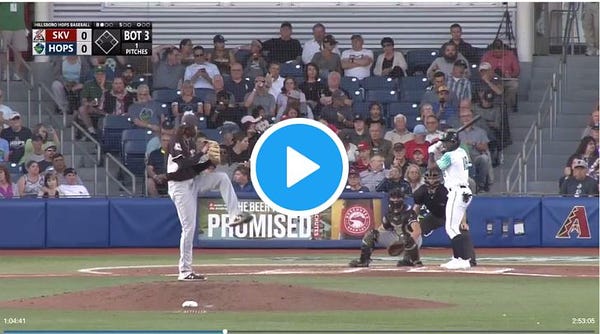
#32. Victor Bericoto, 1b/OF
DOB: 12/3/01
2019 Highest Level: Rookie (Domestic)
Potential 2021 Level: Rookie (Domestic)
Acquired: Drafted, 7th Rd (2019)
Future-Value Grade: 40 (Risk: Extreme)
The Giants tremendous 2018 haul on the J2 market is just the gift that keeps on giving. They spent big money at the top of the market on star players who are, so far, like bargains (Marco Luciano, Luis Matos). But they didn’t end their excellent efforts there. They’ve also seem to have come home from the market with real bargains!
Above I quoted Ben Badler as saying you know you’ve had a great haul when Rayner Santana’s destruction of the Dominican Summer League only counts as the fourth best player of the class. And here’s the thing — it doesn’t. Santana was probably just the fifth best player in the class and that’s because of the great work Victor Bericoto produced.
Bericoto’s season got a little lost in all the good development stories of 2019 — but it shouldn’t. His .472 OBP was second among qualified hitters in the massive DSL while his .344 batting average and .956 OPS were both in the league’s top 10. Like Luis Toribio before him, Bericoto is the rare international teenager who came to pro ball with an advanced approach at the plate and his 53 BB paced the circuit. He has a relatively short, direct swing that still produces plenty of loft and should grow into solid power as he grows —especially given his knowledge of the strike zone. Here he is hitting one of his 5 homers in the DSL, well out to deep LCF:
While he saw the majority of his playing time in the DSL at 1b, the Giants did also work him into the corner OF rotation and as a Right-handed hitter and thrower his best path to value is sticking in the OF. But that certainly seems doable and, indeed, the Giants listed Bericoto among their OFs on the Instructional League roster.
As I’ve been repeating throughout these lists, assignment decisions play a significant role in my rankings as they’re one of the best trace indicators of the Giants’ evaluations. Bericoto, along with Luis Matos, got the extremely rare in-season promotion stateside last year, finishing up the year in the AZL. He followed that up with invitations to spring training and this fall’s instructional league where he made sure he was staying on the Giants’ radar with swings like this:
#31. Esmerlin Vinicio, LHP
DOB: 1/31/03
2019 Highest Level: N/A
Potential 2021 Level: Rookie (Domestic)
Acquired: International Free Agent (2019)
Future-Value Grade: 50 (Risk: XX Extreme)
So here we cross the Rubicon. Just on the precipice of the top 30 we find the first player that I’m assigning a 50 FV (average major leaguer) to — although I’ve hedged my bets by inventing the rare Double X Extreme Risk rating. We aren’t entering the land of the 50 FV yet at this point — that would be a ridiculously stacked system (or more likely a ridiculously bad bit of grading on my part). In fact we aren’t going to see another of these for quite some time. And there’s something ludicrous in even suggesting that a skinny little teenager who has yet to make his pro debut — who wasn’t even allowed to pitch in games in the Tricky League last year after signing — might be an average major leaguer in the making. If you’re prone to skepticism in the case of teenage pitchers, you may commence skepticizing right about now.
Once again I’ll defer to Ben Badler to explain from his appearance on There R Giants Pod-6:
Vinicio I saw initially when he was like 14, he probably weighed 130 lbs but he had this really, really easy delivery. He’s put on some weight and grown a little taller since then. I think he was at that time 83-86 and now he’s been up to 92 and there’s still a lot of room to pack on more size and see that fastball grow. The Giants didn’t pitch …Vinicio during Tricky or Dominican Instrux — they just said “there’s no rush, just focus on strength and conditioning and in Vinicio’s case just focus on calories.”
So what we’re looking at is your classic “projectible lefty” who’s about 1.5 years behind Kyle Harrison in age. If you recall from my talk with Harrison’s high school coach David Jeans, at about the same age Harrison was progressing from throwing 81 as a high school freshman to 93/94 as a senior and, now, up to 97 in Instrux. That’s not to say that every 14 year old lefty will follow that path, of course, but Vinicio’s delivery and projectibility have had Giants’ — and industry — scouts excited for several years now. The 17-year-old was the youngest player at the Giants recently-concluded Instructional Camp and though we haven’t heard anything of his performance there, the mere fact that he was invited to the Scottsdale camp, rather than waiting for Dominican camp to begin, is indicative of the organization’s faith in him.
While Vinicio’s professional journey thus far has been about strength, conditioning, and nutrition — about getting him ready physically to compete — sometime in 2021 he should get on the mound for a game that counts and start showing the world his stuff. It’s a long climb ahead with all the normal landmines that dot the landscape of pitcher development, but Vinicio could be on a trajectory that takes him to top of the Giants’ prospect lists in a few years and hopefully beyond that to the top of the Oracle Park pitching mound. That’s the dream anyway.
As usual, tell me where I’m wrong in the comments!
Minor League Shuffle Redux
I don’t want to go too far down this rabbit hole as we’ll quite probably get confirmed facts before Thanksgiving, but Hank Schulman reported this week that the Giants’ are likely to end their relationships with both Augusta and Richmond — probably not of their own will:
I noted previously that Sacramento, San Jose, and Salem-Keizer seemed the most likely places for the Giants AAA and A ball affiliates — although there are other NWL cities that could be substituted for SK, including Eugene and Boise (which has the same ownership group as Augusta). Either way it seems clear now that San Jose will be the Giants Low A affiliate, and some NWL franchise will be its High A affiliate.
The Richmond situation is different as that apparently is connected to the Nats getting out of their unwanted Fresno situation. Presumably the Nats might want Harrisburg and Richmond as their AA and AAA affiliates with one of those two being boosted up out of the Eastern League into the International league. Where that would leave the Giants in terms of a AA affiliate is hard to say but one intriguing option is the brand new, never-before-played-in facility in Wichita which was supposed to have its inaugural year in 2020 as Florida’s AA team. As the Marlins are now looking to consolidate their AA and AAA affiliates within the state of Florida (with Jacksonville becoming their AA team) that puts Wichita’s brand new stadium up for grabs and it may well be the closest AA team in the country to San Francisco. On the other hand, San Antonio is rumored to be in line for a demotion to AA. That would be a much less desirable location with a stadium that is more than a quarter century old and a long Dodgers’ history that they’re still proud of.
Still much more to come, but we may have the full story not too long after the upcoming owners’ meetings, as J.J. Cooper has speculated. It feels like the dominoes are all starting to tumble now.

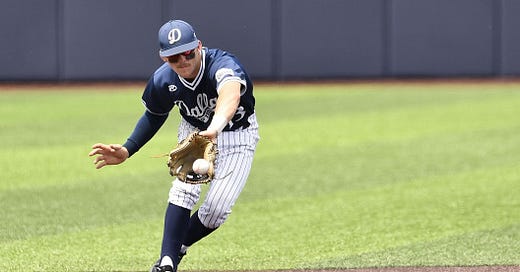



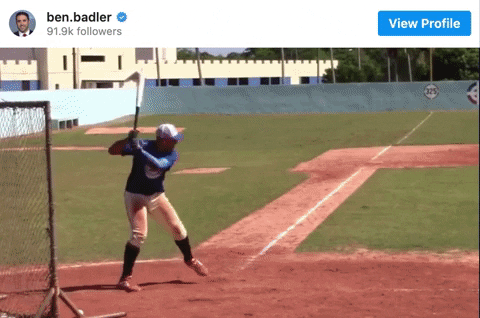

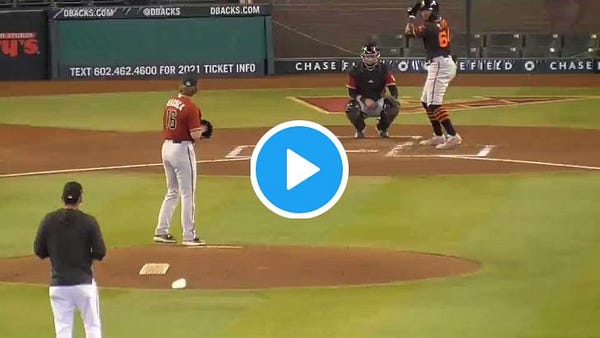

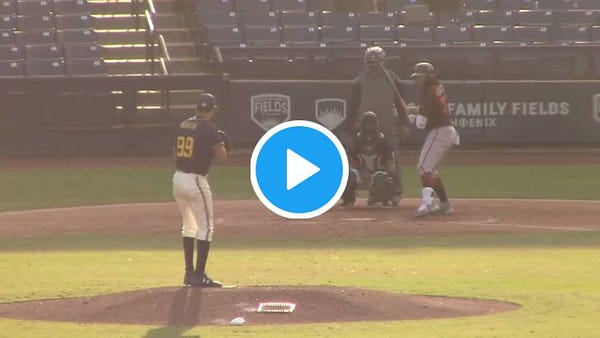
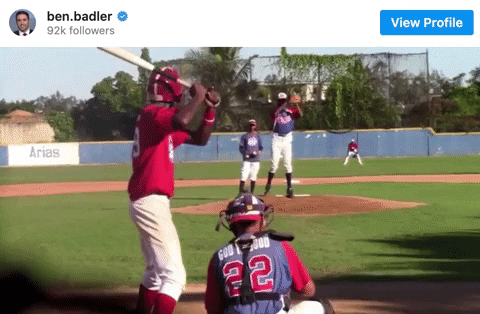

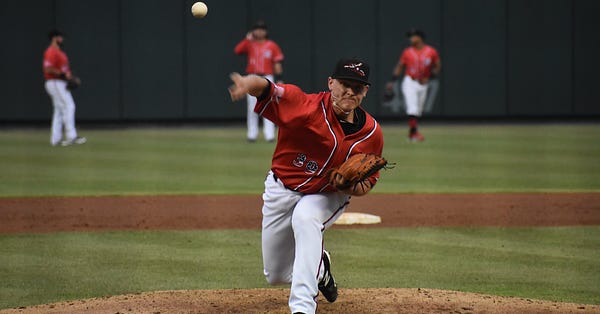
I moved to the NoVA area mid-August last year and was excited about the PNats being right there and the Squirrels being a two-hour drive away. So what happens? The PNats move to Fredericksburg, which is traffic hell, and now I won't be able to see Giants' prospects in Richmond either. I did get to see Matt Cain rehab there once, and my dad is always proud of seeing Matt Duffy there and calling him as a future major leaguer. I also missed out on Ramos in Augusta by going the year before the new stadium opened (and he was there) and in Richmond. I just want minor league ball back, even if I can't see Giants affiliates.
waah.
sad about the real possibility of no giants-affiliated minor league ball on the east coast. i doubt i'm the only one. there are thousands upon thousands of ancestral giants fans here whose connection with the big league club has been strengthened by our regular attendance of minor league games.